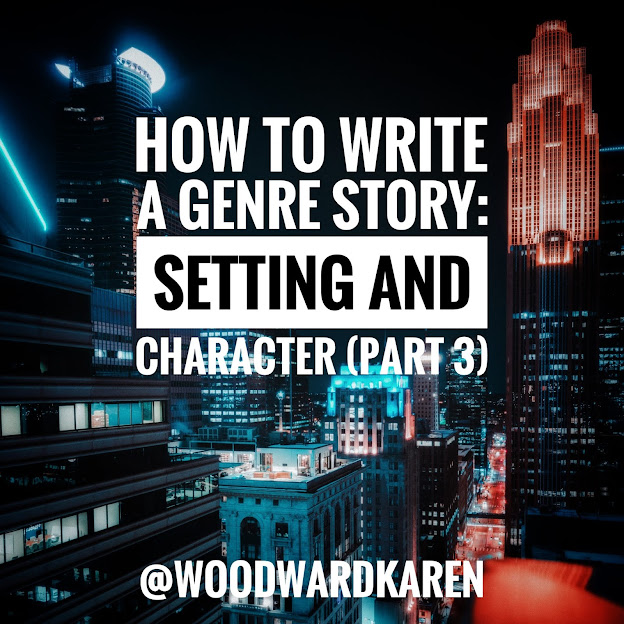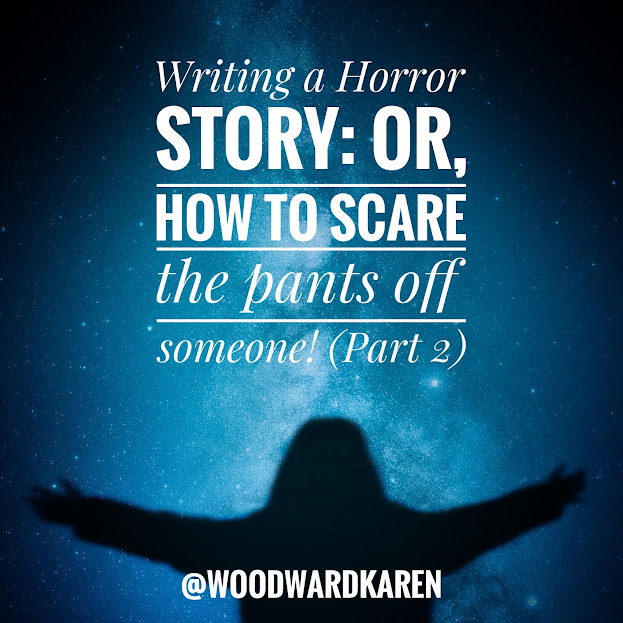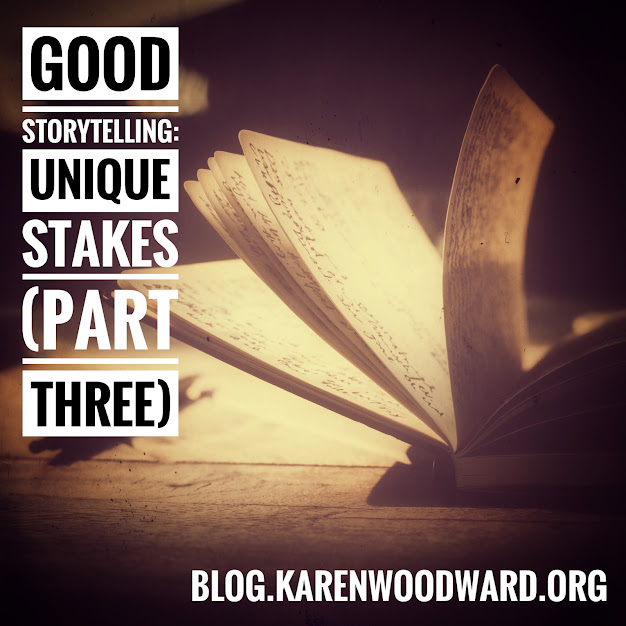Summary: Setting is an essential part of good writing because a well developed setting helps a writer show rather than tell. Each object in a story has a function, a purpose, a goal. This implies that if we were to get a peek into the hero's--or villain's--lair, that simply by looking at the objects that are most important to him would allow us to, in a sense, read the character's mind. We would know who they really were, what they wanted as well as what their goals were. In what follows I unpack this idea.
Nothing is more important to character development than setting.
At least, that’s what I think. After you’ve finished reading this, let me know if I’ve convinced you.
Setting enables a character to become who they really are and, in so doing, shows what that character wants and why they want it. Setting puts the character’s passions on display, it reveals their loves, hates, fears, strengths and weaknesses.
Don’t believe me?
It will take me a few paragraphs to develop this idea, so hang in there. It’ll be worth it.
Things and Goals
Look around. You’re surrounded by things. I’m sitting cross legged in my black office chair typing on a keyboard. There are miscellaneous pens scattered in front of me, a coffee grinder, a pair of reading glasses, a magnifying glass, a box of sticky notes, a desk lamp and a cup full of steaming hot coffee.
But… So what? What do any of these things mean?
Well, why do I have any of them? I need my pens bcause without them I couldn’t scribble in my writing journal and that wouldn’t be good because that’s how I write most of my rough drafts. Now, I don’t always like writing rough drafts, but I do it because I like eating and having a roof over my head.
Each object on my desk is like my pens in that each has a function and, as such, is tied to a goal.
Here’s another example. When I was a teen one of my best friends, Carl, was always on a diet. His Achilles' heel was junk food, when he was stressed he couldn't resist it.
One day we were meeting up with friends so, being kind, he drove by my place and picked me up so I didn't have to take the bus. When I climbed into his car the first thing I saw was a discarded Big Mac wrapper that had escaped the garbage. That discarded wrapper told me quite a lot about him: he was stressed and, because he'd had a Big Mac recently, he was feeling guilty for cheating.
Goals and Things
Okay, so far so good. Now let’s talk about goals.
In a story, every object is tied to a goal via either it’s function or by what it represents. (If it isn’t tied to a goal, why have it in the story?)
I think that all things--and therefore all goals--could, more-or-less, be said to fall into one of three categories: things we need to SURVIVE, things we use to PLAY and (for lack of a better term) things associated with DEEP MEANING. Let’s look at each of these in turn.
Survival
In life we do certain things (for example, go to work at a job we hate) to get other things (like food and shelter) we need to survive.
My example for this category is a briefcase. A briefcase isn’t wanted in and of itself, but only to the extent that it would help someone achieve their goal of helping them at their job. Now, this isn’t to say that everyone who owns a briefcase hates their job, but my guess is that if 100 briefcase owners were each given 10 million dollars they would quit their jobs and divest themselves of their briefcases. Maybe I’m wrong, but I don’t think so.
This goal is all about removing the negative--starvation and homelessness. There is nothing the person values in itself in pursuing their goal of being employed. I could imagine that some people, upon retiring, burn their briefcases!
Play
We do other things (for example, go fishing) to get things (for example, fish plus a feeling of tranquility) that we like. As with the above category, certain objects, certain ‘things,’ can be associated with this activity. For example, a fishing rod. A fishing rod isn't wanted in and of itself, but only to the extent that it would help someone achieve their goal of helping them catch fish.
But, unlike the survival category, this goal is not just about removing the negative, it is also about introducing a positive, desired, emotional or mental state. Associated with this kind of goal is something a person values in itself (for example, a feeling of wellbeing). I could imagine that some people, upon retiring from fishing, still keep their fishing rods as a reminder of good times, or perhaps they gift it to a young friend.
I’ll talk more about this, below, but of course while we perhaps have a stereotype in our heads about what the ‘average’ fishing experience is or why people fish (I fished quite a bit as a child) of course not all people have positive experiences or mental states associated with fishing. In this case such a person might toss their fishing pole into the garbage (similar to the briefcase). BUT this would be unusual and so would (or so I think) make us curious WHY. We don’t need an explanation for why a person would enjoy fishing, but we do need one for why they hated it. Again, this is my claim, please feel free to disagree!
Deep Meaning
We do still other things (for example, get married) to get things (a family as well as a purpose in life) that we love, things that bring a deeper meaning to life, things that help us structure our life, things that provide a framework. I’ve called this category ‘deep meaning.’
Certain objects, certain ‘things,’ can be associated with states-of-affairs that bring our lives deeper meaning. For example, a wedding ring. Generally speaking, the ring isn’t wanted in and of itself, but only to the extent that it symbolizes the desired state-of-affairs of being married, of the commitment one spouse has made to another. This state-of-affairs is something the person values for itself and it will greatly change their life and how they move about in the world.
I would expect that were the relationship to end suddenly that the nature of the relationship and the reason for its termination would affect one’s attitude toward one’s wedding ring. For example, if a beloved spouse passes on then I would imagine the ring would be treasured, kept. If John has a nasty divorce I wouldn’t be surprised were he to toss his wedding ring into the ocean or garbage can.
What we have so far:
There are certain objects (e.g., briefcases) that are stereotypically associated with negative things and others (e.g., wedding rings) that are stereotypically associated with deeply meaningful wonderful things (e.g., marriage). Still others (e.g., fishing rods and playstations) have some emotional valence that falls somewhere in between the two.
So, to recap. The idea is that objects have functions and that these functions imply particular goals. Therefore, when writing a story, in introducing an object with a particular function or one that represents a certain thing, you are also introducing a goal, one that might say quite a lot about the character.
This is an essential part of showing not telling.
Using Setting to Show Not Tell
An example: Carl
Let’s go back to the example of my friend Carl. The Big Mac wrapper implied something about his goals and the extent to which he was achieving them. If I were writing a story about Carl, the discarded McDonald’s wrapper would say quite a lot about my friend’s success in achieving his weight loss goals. But, also, and more importantly, it would tell me he was under a lot of stress. He wouldn’t have to say anything to me in order to communicate this information, all I needed to see was that discarded wrapper. That’s a big part of showing and not telling.
So there are objects, and objects have a function, and objects are tied to goals via their function. Also, we have either positive or negative feelings about an object based on loosely two things: First, how we feel about the goal and, second, how efficiently the object gets us to that goal.
You can see where I’m going with this. Since the possession of an object can imply a goal, a desire, what objects your characters have in their homes, their private abodes, say quite a lot about first, what face they want to present to the world and, second, what they really care about. It can tell the reader what the character loves, what she wants, what she hopes to achieve. That goes to the essence of characterization.
But that’s not all.
Kicking it up a notch: Breaking Stereotypes
This is really what this post is about: How to use the juxtaposition of setting and character to create conflict and surprise. But before I talk about that let’s get more specific about desires and goals.
Mixing it up: Subversion of Expectation
Comedy
Comedy often results when an object that is used for play is used instead for survival. For example I can imagine a modern day Wednesday (from the Addams Family) being forced to play on a Playstation as though it were much loathed homework. This would tell us A LOT about Wednesday and the values of the Addams family.
One of the things that separates an entertaining story from a boring one is that an entertaining story will have a few of these surprises.
How do we do this?
One way we can both surprise and intrigue the reader is to take an object that is commonly associated with one category--say a wedding ring--and have a character feel about it the same way we normally feel about a briefcase.
Terror
Have you seen the 1987 movie Black Widow, the one starring Debra Winger? Here’s the description from IMDB: “A federal investigator tracks down a gold-digging woman who moves from husband to husband to kill them and collect the inheritance.” So, for Catherine, the murderer, her wedding ring had the same emotional significance as a new briefcase would have for the average person. When it comes to understanding such a person that’s a valuable piece of information! That sort of thing paints a powerful picture.
Or how about this: Imagine you have next a door neighbour who everyone thinks adores his wife. She passes after a lengthy illness. He seems devastated. A couple of days after she passes there is a bad windstorm and garbage cans are tipped over, their contents strewn about all over the block. On your way to the store you pass your bereaved neighbours home and see that the wind has tossed the contents of his garbage can all over the road. There, in front of you, is his wife's wedding ring. That would be a good opening for a mystery!
The Harry Potter stories used this device. There are two things here. First, school is more in the survival category, not many children are terribly excited about going to school or doing homework. But J.K. Rowling, first, made a character--Hermione--who loved doing homework like many people love football or hockey.
Second, the entire school is one that many of Rowling’s readers dreamt of attending! She took something--schooling--that usually is in the “I need to do something I don’t like” category and put it in the “play” category by uniting it with the idea of wizardry, of learning how to control magic.
Show Don’t Tell
You might be thinking: well, Woodward, isn’t that all just a part of characterization? Yes! But to SHOW who a character is we want to have the character react to something important to them--to someTHING in the setting. In doing so, the character will be brought to life.
(Jim Butcher has written about how to create an interesting character.)
Also, when we take a thing that normally belongs in one category and put it in another, our character is shown to be unusual. That’s a good thing because unusual characters are memorable characters, and memorable characters are fun to read about.
Finally, a thing that characterizes the fictional person is the relative proportion of, say, survival items to play items. Or play items versus deep meaning items. What would it say about a character if his man cave had NO deep meaning items, NO survival items but a lot of play items? He would seem to be a playboy, a dilettante, someone who was truly interested in nothing and lived only for the pleasure of the moment. But (putting a twist on this) what if (as in The Scarlet Pimpernel or Batman) our hero had a secret room that was full of objects from the survival and deep meaning categories? That would indicate that his playboy image was a ruse, a smokescreen.
Summary
It’s fun for me to think about objects this way, it helps me understand the characters I’ve loved in new ways. I hope you’ve gotten something from my ramblings, perhaps a slightly new way of thinking about something you’ve always instinctively known. I hope it was worth it. 😀
(By the way, if you write--you don't have to have anything published--and would like to be interviewed, tweet at me (@WoodwardKaren).)
Thanks for reading! This post took me a long time to write, I’m hoping to have my next blog post up next week. Good writing.
Other posts in this extended series (I'm blogging a book):
How to Write a Genre Story: The Index










